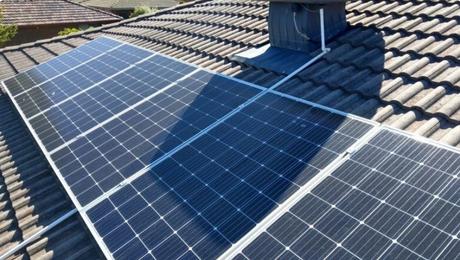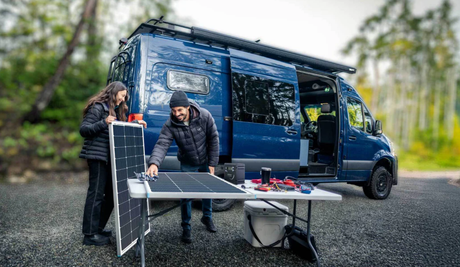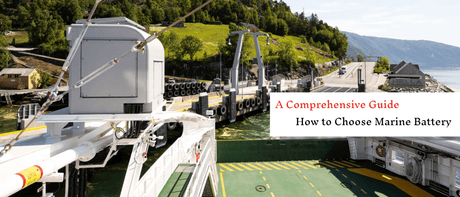How to Charge a Deep Cycle Battery If you've ever owned an RV or a boat, you know that deep-cycle batteries are essential for keeping the lights on and the fridge running. But what do you do when it's time to charge them? In this blog post, we'll walk you through the basics of charging a deep-cycle battery.
Let's get started!
Table of contents:
- What is a deep cycle battery? And why do you need one?
- How to charge a deep cycle battery?
- Best way to charge a deep-cycle battery
- How long does it take to charge a deep cycle battery?
- How long can a deep cycle battery last without charging?
- Why should you never overcharge your deep cycle battery?
- Common types of deep-cycle batteries
- Check out our Lithium deep-cycle batteries
What is a deep cycle battery, and why do you need one?
A deep cycle battery is a rechargeable battery designed to be regularly discharged "deeply" using most of its capacity. This type of battery is ideal for applications where the charging and discharging need to happen consistently, such as powering an RV or for marine use, as well as more consistent uses like backup power sources in telecoms and solar systems.
When charging a deep cycle battery, it's important to ensure that charging time and charging speed have been accurately measured to attain optimum performance from the battery.
How to charge a deep cycle battery?
Charging a deep-cycle battery doesn't have to be a difficult task as long as you follow this guide. There are several ways to charge a deep cycle battery, no matter what type of batteries you have. Solar power Grid power Alternator and starter battery
First, if you go with solar power, you need to invest in a solar power system which includes solar panels, one or two charge controllers, and inverters. This means a large amount of cost is required. But the benefit of solar power systems can pay back gradually once you start using solar energy instead of grid power or fossil fuels.
The second choice is you can utilize the AC power from your grid to charge your deep cycle battery, but that entails a suitable AC to DC battery charger. For example, lithium batteries cannot be charged with a regular charger designed for lead acid batteries, but a specially designed charger like this Renogy 12V 20A AC-to-DC LFP Portable Battery Charger.
When neither of the methods above is suitable for you, you can still try to charge your deep cycle battery through the alternator and the starter battery which must work together, but the process requires a built-in DC to DC On-Board Battery Charger.

With proper maintenance and care, you can ensure that your battery is safely storing energy for years to come.
Best way to charge a deep-cycle battery
Charging a deep-cycle battery is vital to battery maintenance and prolonging its life. That’s why you need a suitable charger whichever method you choose to charge the battery. Most battery chargers are designed with multiple charge stages so the batteries will not be overcharged or undercharged.
The charging stages include:
1.Bulk charging: the battery will be charged up fast in this stage;
2.Absorption charging: when the battery is almost topped up, its voltage will reach a certain level, at which the absorption charging will be activated to slow the influx of current and hold it constantly.
3.Float charging: when the battery is fully charged, the charger enters the float charging process, which feeds the battery with a tiny amount of current so to keep it at full capacity during long-term storage.

Therefore, the best way to charge a deep cycle battery is by using a battery charger or charge controller specifically designed for a certain type of a battery. When choosing the charger, ensure the charge rate remains within parameters and does not surpass the battery's capacity. Always refer to the manufacturer's instructions for charge rates; if overcharging occurs, the battery's electrolyte levels may become unbalanced, reducing its lifespan. When used correctly, deep-cycle batteries can provide many years of reliable service.
How long does it take to charge a deep cycle battery?
Charging a deep-cycle battery is important for ensuring its long-term health. The exact time it takes to charge depends on the type of charger being used, the size and type of battery, and the level of charge that was originally in the battery.
Generally, it can take anywhere from an hour to 24 hours to fully charge a deep cycle battery, depending on those factors. A good rule of thumb is to divide the amp hours of your solar battery by amps delivered by your solar panels, battery charger, or the alternator and battery charger.
For example, If you have a solar power system with three 100-watt solar panels in series which would deliver a current of 25 amps in ideal situations, and a 12V 100Ah lithium battery. Fully charging the battery would take four hours. Here’s the equation: 100Ah/25A=4hrs.
Calculating the charging time for other charging method follows suit. Divide the amp hours of your battery by input amps.
How long can a deep cycle battery last without charging?
When discussing this question how long can a deep cycle battery last, there are service lifespan and cycle life we can talk about.
Different types of deep cycle batteries are characterized with varied length of service lifespan. Typically, when with good maintenance, lead acid batteries like AGM batteries last with a period of six to ten years, gel batteries survive about six to ten years, and flooded lead acid batteries last three to five years. Lithium batteries, a latest developed and flourished battery technology, boast a life expectancy of 15 to 20 years.

When it comes to life cycle, these batteries also have varied performance. For example, a flooded lead acid battery typically has 250 to 1200 cycles, an AGM battery can release 500 to 1200 cycles, gel batteries offers 500 to 2000 cycles, and lithium batteries ensure a range between 2000 to 5000. Renogy’s 12V 100A smart lithium iron phosphate battery supports over 4000 cycles at 80% DOD.
So how long can a deep cycle battery last without charging in a cycle? It depends on many factors like temperature, age of the battery, amount of current drawn, and quality of the battery. Generally speaking, a brand new deep cycle battery in optimal conditions with little to no current drain can last up to 6 months before needing a recharge. If it's a lead acid battery, keep an eye on water levels.
It is best practice to charge your deep cycle battery every 3-4 months with an adequate charger that has voltage levels specifically tailored for deep cycle batteries.
Why should you never overcharge your deep cycle battery?
Overcharging a deep-cycle battery can negatively impact its performance and even cause it to fail. When a battery is overcharged, it causes additional strain on the cells, leading to the degradation of the plates, an increase in the build-up of dangerous gases, and an overall decrease in the life span of the battery.

Too much voltage also increases the heat inside the battery, which could lead to a thermal runaway that could cause a fire. To ensure optimal performance and safety with deep cycle batteries, you should always use a quality charger designed specifically for deep cycle applications that will shut off when it detects full charge or trickle charge as needed without ever overcharging the battery. Investing in a quality charging system could save you money by extending your battery's life expectancy and keeping your gadgets running for years to come.
Common types of deep-cycle batteries
The two most common types of deep-cycle batteries you'll find are Lithium and lead acid.
Lithium batteries are superior to lead-acid batteries in many ways. For one, lithium batteries can hold their voltage over the entire cycle, whereas lead acid batteries will begin dropping off almost immediately.

This means that you get more power out of a lithium battery than you would with a lead-acid battery, allowing you to generate more energy every time you charge it. Lead acid deep cycle batteries are limited in the number of amps they can discharge, unreasonably limiting the types of appliances they can run while lithium batteries provide unlimited potential for generating ample electric power.
Learn more about deep cycle batteries in this article: What Is A Deep Cycle Battery?
Check Out Our Lithium Deep-Cycle Batteries
Renogy believes in only supplying the best batteries we can. This is why we designed our deep-cycle lithium iron phosphate batteries to be industry-leading in technology and features. Our batteries lead the way with their ability to be charged and discharged to 80% for 2000 to 4500 cycles!
Related articles:
Adding Or Replacing A Boat Battery
What is the Best Solar Battery for Solar Storage in Canada?
Best Batteries For Solar: Deep-Cycle Batteries For Storing Solar Energy
How To Select The Best Inverter Charger For Your Solar System?










